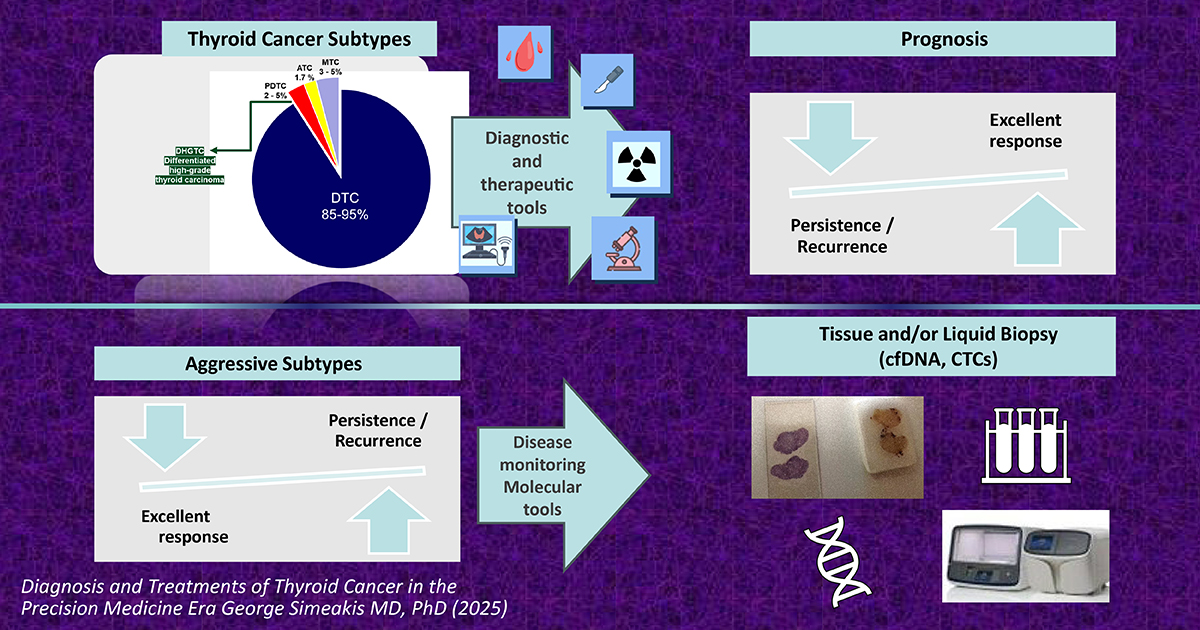Diagnosis and Treatment of Thyroid Cancer in the Precision Medicine Era
A special issue of Medicina (ISSN 1648-9144). This special issue belongs to the section "Oncology".
Deadline for manuscript submissions: 31 March 2026 | Viewed by 4079

Special Issue Editors
Interests: endocrine; thyroid cancer; endocrine oncology; neuroendocrine tumors; clinical endocrinology
Special Issue Information
Dear Colleagues,
Thyroid cancer (TC) is the most frequent endocrine malignancy, albeit it accounts for about 4% of all cancer types. The latest guidelines of the American Thyroid Association regarding Differentiated (DTC), Medullary (MTC), and Anaplastic Thyroid Cancer (ATC) provide thorough recommendations regarding the appropriate therapeutic management of TC patients (i.e., diagnostic assessment, surgical procedure, post-surgical treatment, and follow-up). Nevertheless, issues arise in real-life practice, especially when the physician has to deal with aggressive histological types and, moreover, when initial response to therapy is not excellent. Advanced forms of TC (i.e., metastatic Radioiodine Refractory DTC, MTC, and ATC) pose a challenge in clinical practice, and questions like when and where to use the available diagnostic tools and therapeutic options are of great importance to be answered towards precision medicine implementation. Tumor molecular profiling using Next Generation Sequencing (NGS) analysis, both on the tissue as well as on the Circulating Tumor DNA (ctDNA) and Circulating Tumor Cells (CTCs) level, is an intriguing tool providing information regarding prognosis and possible targeted-treatment options. In this Special Issue, we welcome original studies and reviews on the diagnosis, molecular pathways, and therapy of thyroid cancer. We especially welcome contributions focused on advanced TC, as described above, molecular pathways involved in TC pathogenesis and targeted treatment, and the clinical utility of molecular tools.
Dr. Maria Boudina
Guest Editor
Dr. George Simeakis
Guest Editor Assistant
Manuscript Submission Information
Manuscripts should be submitted online at www.mdpi.com by registering and logging in to this website. Once you are registered, click here to go to the submission form. Manuscripts can be submitted until the deadline. All submissions that pass pre-check are peer-reviewed. Accepted papers will be published continuously in the journal (as soon as accepted) and will be listed together on the special issue website. Research articles, review articles as well as short communications are invited. For planned papers, a title and short abstract (about 250 words) can be sent to the Editorial Office for assessment.
Submitted manuscripts should not have been published previously, nor be under consideration for publication elsewhere (except conference proceedings papers). All manuscripts are thoroughly refereed through a single-blind peer-review process. A guide for authors and other relevant information for submission of manuscripts is available on the Instructions for Authors page. Medicina is an international peer-reviewed open access monthly journal published by MDPI.
Please visit the Instructions for Authors page before submitting a manuscript. The Article Processing Charge (APC) for publication in this open access journal is 2200 CHF (Swiss Francs). Submitted papers should be well formatted and use good English. Authors may use MDPI's English editing service prior to publication or during author revisions.
Keywords
- thyroid cancer
- molecular
- personalized
- targeted
- advanced thyroid cancer
- medullary
- liquid biopsy
Benefits of Publishing in a Special Issue
- Ease of navigation: Grouping papers by topic helps scholars navigate broad scope journals more efficiently.
- Greater discoverability: Special Issues support the reach and impact of scientific research. Articles in Special Issues are more discoverable and cited more frequently.
- Expansion of research network: Special Issues facilitate connections among authors, fostering scientific collaborations.
- External promotion: Articles in Special Issues are often promoted through the journal's social media, increasing their visibility.
- Reprint: MDPI Books provides the opportunity to republish successful Special Issues in book format, both online and in print.
Further information on MDPI's Special Issue policies can be found here.







